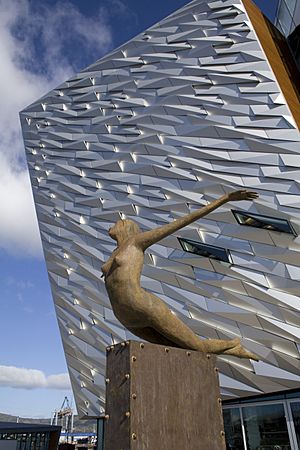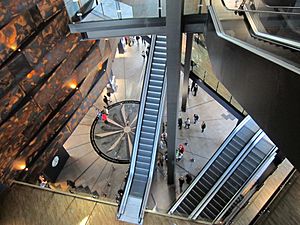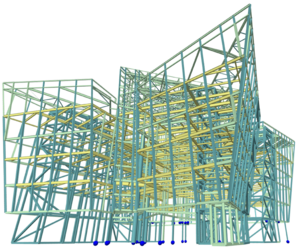Titanic Belfast facts for kids
Quick facts for kids Titanic Belfast |
|
|---|---|

Titanic Belfast
|
|
| General information | |
| Location | Belfast, Northern Ireland |
| Country | Northern Ireland |
| Coordinates | 54°36′29.97″N 5°54′35.09″W / 54.6083250°N 5.9097472°W |
| Construction started | May 2009 |
| Opened | 31 March 2012 |
| Cost | £101 million |
| Height | 38.5 m (126 ft) |
| Design and construction | |
| Architect | Eric Kuhne and Associates |
Titanic Belfast is a popular place to visit in Northern Ireland. It opened in 2012. This amazing building celebrates Belfast's history of building ships. It stands where the famous RMS Titanic was built, in an area now called the Titanic Quarter.
The museum tells the stories of the Titanic, which sadly hit an iceberg and sank on its first trip in 1912. It also shares tales of her sister ships, RMS Olympic and HMHS Britannic. The building has a huge amount of space, about 12,000 square metres (130,000 sq ft), filled with galleries, event rooms, and community areas.
Titanic Belfast is looked after by the Maritime Belfast Trust. It is run by Titanic Belfast Limited.
Contents
History of the Titanic Belfast Building
The building is on Queen's Island, a piece of land in Belfast Lough. This land was created by filling in water in the mid-1800s. For many years, the shipbuilders Harland and Wolff used this area. They built huge slipways (ramps for launching ships) and dry docks (places to build and repair ships). This allowed them to build the Olympic, Titanic, and Britannic all at once.
When shipbuilding in Belfast slowed down, much of this area became empty. Many old structures were taken down. However, some important historical features were saved. These included the slipways and dry docks where the Olympic, Titanic, and Britannic were built. The famous Samson and Goliath cranes were also kept.
In 2001, the empty land was renamed the "Titanic Quarter". Plans were made to bring the area back to life. Developers bought a large part of the land to build new homes, hotels, and fun places. They also planned a museum about the sea and a science center. In 2005, the idea for a museum just about the Titanic was announced. The goal was to finish it by 2012, to mark 100 years since the Titanic's first voyage and sinking.
Many ideas were thought of for the attraction. One idea was to rebuild the giant Arrol Gantry, a huge structure used to build the ships. Another was to make a glowing outline of the Titanic in the dock. In June 2008, details of the project were shared. It was called the "Titanic Signature Project." The government of Northern Ireland agreed to pay half the cost. The other half came from private companies and the Belfast Harbour Commissioners. Belfast City Council also promised money.
Harcourt Developments took on the job of creating the visitor attraction. They worked with American architect Eric Kuhne and British exhibition designers Event Communications. The building, now called Titanic Belfast, was expected to attract many visitors. It was hoped to help bring new life to the city, much like the Guggenheim Museum Bilbao did for its city. It is part of many Titanic-related sites in the Titanic Quarter. These include the old Harland & Wolff offices, the SS Nomadic (the last surviving ship from the White Star Line), and the Titanic slipways.
Visitor Numbers and Awards
Titanic Belfast has been very popular since it opened. In its first year, it had over 800,000 visitors, much more than expected. Many of these visitors came from outside Northern Ireland. The attraction has also hosted many events.
In 2016, Titanic Belfast won the "World's Leading Tourism Attraction Award." This was a big achievement! In 2017/18, it had a record number of visitors, with over 840,000 people coming through its doors. Most of these visitors were from outside Northern Ireland.
In 2023, Titanic Belfast was the most visited tourist attraction in Northern Ireland. It welcomed over 800,000 people. Since opening in 2012, the museum has won fifteen awards. It has helped a lot to improve tourism in Northern Ireland. Many famous people have visited, including Queen Elizabeth II, and Robert Ballard, the person who found the Titanic wreck.
Building Design and Construction
Eric Kuhne and Associates were the main architects for the idea. Todd Architects helped with the detailed plans. The building's look shows Belfast's history of building ships. Its sharp, angled shape looks like the front (prow) of a ship. The main "prow" points down the middle of the Titanic and Olympic slipways towards the River Lagan.
Most of the building's outside is covered with 3,000 shiny silver aluminum pieces. It stands 126 feet (38 m) tall, which is the same height as the Titanic's hull.
Inside, the eight-story building has 12,000 square metres (130,000 sq ft) of space. The main part is a series of galleries. These galleries explore how the Titanic was built, designed, and how it sank. They also cover what happened after the disaster. On the top floor is the Titanic Suite, a large space for conferences and events. It can seat 750 people.
A copy of the Titanic's famous grand staircase is in this conference center. This staircase became well-known from the 1997 James Cameron film Titanic. It was a big challenge to build this replica. It has 10,000 separate parts and weighs almost four tons!
The building also has places for education, community events, shops, and restaurants.
How the Building Was Designed to Stand Up
The Titanic Belfast building has a very special design. Its steel frame is "inverted," meaning the floors get bigger as you go higher up. Engineers used special computer programs to make sure the building would be strong and stable. They had to be very careful because of the building's unique shape and tall sections.
How the Building Was Built
Building the Titanic Belfast cost £77 million. Another £24 million was spent on planning, preparing the site, and building the underground car park. The foundations of the building needed a huge amount of concrete. About 4,200 cubic metres (150,000 cu ft) of concrete was delivered by 700 trucks in just 24 hours!
In front of the building is a sculpture called Titanica by Rowan Gillespie. It shows a female figure diving. It is made of bronze and sits on a brass base. This sculpture is meant to represent hope and good feelings. It was officially opened a few days before Titanic Belfast opened in March 2012.
Hickson's Point
Opened in March 2018, Hickson's Point is a bar designed to look like a real Belfast pub from the early 1900s. Its name comes from Robert Hickson, one of the first shipbuilders in Belfast.
Exploring the Museum Rooms
The Titanic Belfast museum has nine interactive galleries. Each gallery tells a different part of the Titanic story:
- Boomtown Belfast: The City in the Early 1900s
This gallery shows what Belfast was like when the Titanic was being built (1909–1911). You can see scenes from the city's main industries. Then, you walk through real gates from the Harland and Wolff shipyard. An interactive floor shows the Titanic's building plans and models of the ship.
- The Shipyard: A Ride Through History
This gallery has a tall steel structure, 20 metres (66 ft) high, which reminds you of the huge gantry used to build the Titanic. A lift takes you to the top, where you can see and hear about shipbuilding. Then, you get into a six-seater car. It takes you on a ride through a recreated shipyard, even moving through a huge copy of the Titanic's rudder!
- The Launch: Watching Titanic Enter the Water
This gallery shows scenes from the day the Titanic was launched into Belfast Lough. About 100,000 people watched this event! You can look out a window that shows the actual slipway where the Titanic was launched.
- The Fit-Out: Getting Titanic Ready
This gallery has a large model of the Titanic. It shows what the ship looked like for its passengers and crew, including all three classes of cabins. A special feature lets you take a 360-degree computer tour of the Titanic, from the engine room to the dining rooms and the bridge.
- The Maiden Voyage: The Journey Begins
This gallery shows the ship's first, tragic journey. You can walk on a wooden deck, sit on benches, and look out at the docks. The gallery also has photos of the ship taken by Father Francis Browne, who was on the Titanic for part of its trip.
- The Sinking: The Disaster of April 1912
This gallery shows the sinking of the Titanic. You can hear Morse code SOS messages in the background. Images of the sinking are shown with sounds of survivors telling their stories. A wall of 400 fake life-jackets represents the iceberg, with an image of the sinking ship projected onto them.
- The Aftermath: What Happened Next
This gallery looks at what happened after the sinking. It has a full-size copy of one of the lifeboats used to save passengers. Videos and information panels explain the investigations into the disaster. You can use interactive screens to search for passengers and crew members. The gallery also shares information about Harland and Wolff and the Titanic's sister ships.
- Myths & Legends: Stories About the Titanic
Many stories and myths grew from the Titanic disaster. This gallery explores these legends, which have been shared through films, plays, books, and poems. With Celine Dion's song My Heart Will Go On playing, you can learn about the popular culture inspired by the Titanic.
- Titanic Beneath: The Wreck and Its Discovery
The last gallery shows the Titanic as it is today, 12,000 feet (3,700 m) deep in the North Atlantic. This part was created with Dr. Robert Ballard, who discovered the wreck. You can see videos, hear audio, and view images from his expeditions. A special glass floor lets you see a fish-eye view of the wreck. Below this floor is the Ocean Exploration Centre, where you can learn about sea life and exploration.
|
See also
 In Spanish: Titanic Belfast para niños
In Spanish: Titanic Belfast para niños





